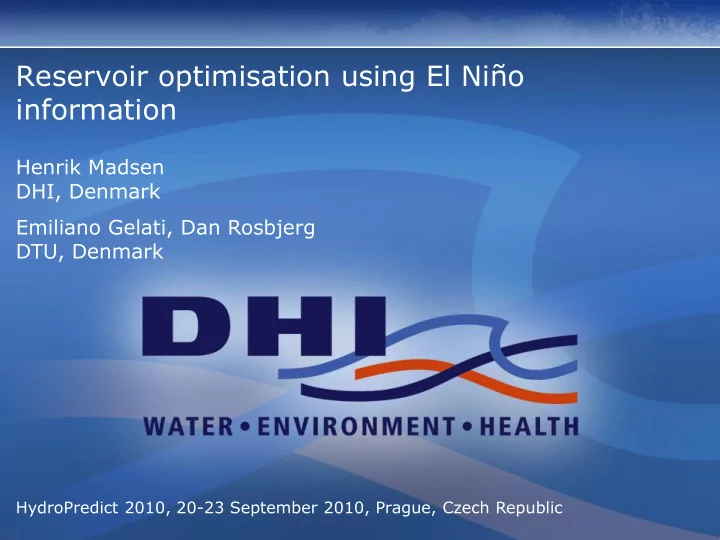

Reservoir optimisation using El Niño information Henrik Madsen DHI, Denmark Emiliano Gelati, Dan Rosbjerg DTU, Denmark HydroPredict 2010, 20-23 September 2010, Prague, Czech Republic
SST anomalies [ o C] El Niño event (December 1997) Daule Peripa Correlation between El Niño events and streamflow regime
El Niño indices Standard indices Forecasts Trans Niño Index (temperature gradient) + - Niño 1+2 (temperature) Daule Peripa
Optimisation of reservoir system Planned extension: Existing: Baba diversion Daule-Peripa Optimisation objectives: Maximise hydropower • Minimise downstream • water deficits Stochastic optimisation: Stochastic inflow • model Reservoir simulation • model NSGA-II optimisation • algorithm
Stochastic inflow model Markov switching autoregressive model: Streamflow driven by a hidden climate state process • Transition between states follow a first order Markov process • Transition probabilities depend on climate state • Streamflow modelled by an ARX model conditioned on climate • state Estimation for Daule-Peripa inflow: Niño 1+2 and trans - Niño indeces • Two state model • Gelati et al., WRR, 2010
Inflow model results Simulation Forecasts (expected values) 9 month lead time 1 month lead time 1200 Observed 3 3 10 10 Expected (simulation) 1000 10% - 90% quantile /s] /s] 3 /s] interval (simulation) 3 800 3 Forecasted inflow [m Forecasted inflow [m Mean annual inflow [m 2 2 10 10 600 400 1 1 10 10 200 0 0 0 10 10 1950 1955 1960 1965 1970 1975 1980 1985 1990 1995 2000 2005 0 0 1 1 2 2 3 3 10 10 10 10 10 10 10 10 Year 3 3 Observed inflow [m Observed inflow [m /s] /s] Major El Niño events Dryest years
Rule curve optimisation Release = f ( storage, month, hydropower water demand ) Chosen policy with water supply 5 curves 12+4 decision variables failure frequency < 10 -3 -3 x 10 86 100% Dominated policies 84 Water supply failure frequency Optimised policies 40% 1 Chosen policy 82 30% 0.8 80 25% Level [m] 78 0.6 20% 76 0.4 74 10% 0.2 72 70 0 Jan Feb Mar Apr May Jun Jul Aug Sep Oct Nov Dec 142.15 142.2 142.25 142.3 142.35 142.4 Expected root mean square hydropower deficit [MW]
Real-time optimisation using inflow forecasts At each time step: 3 /s] 1200 Observed Inflow [m 1. Generate 100 series of 9-month 1000 Single 800 long inflow forecasts (given past forecast 600 400 inflow and El Niño forecasts) 200 0 1 2 3 4 5 6 7 8 9 Months from the beginning of 2006 2. Optimise 9 monthly releases (optimise hydropower in 9- month period and penalise future costs/benefits) 200 3 /s] 150 Release [m 100 3. Implement the first release 50 0 1 2 3 4 5 6 7 8 9 Months from the beginning of 2006 4. Go to the next time step…
Penalty function – storage target Expected optimal hydropower production in a twelve-month period as function of the month and reservoir level (Dynamic Programming on 1950-1999 period)
Optimisation results existing system Root mean Water supply Average square failure generated hydropower frequency power [MW] deficit [MW] Historical 147.0 0 70.6 1.1% 3.5% 144.7 0 71.4 Rule curves 5.7% 142.9 0 73.1 Forecast Dynamic 139.8 0 74.6 programming
Optimisation results existing system Reservoir water level (monthly) Dyn. programming 86 Historical operation 84 Rule curves 82 Forecasts 80 Water level [m] 78 900 76 Inflow 800 700 74 600 /s] 500 72 3 Inflow [m Level 400 300 70 2000 2001 2002 2003 2004 2005 2006 2007 2008 2009 200 Year (beginning) 100 0 2000 2001 2002 2003 2004 2005 2006 2007 2008 2009 Year (beginning)
Optimisation results extended system Average Average Average generated power generated power generated power Daule Peripa Baba Total [MW] [MW] [MW] 70.6 - 70.6 Historical - existing Forecast optimisation - 73.1 - 73.1 existing Dynamic programming - 74.6 - 74.6 existing Forecast optimisation - 129.0 26.3 155.3 extended Dynamic programming - 133.3 26.0 159.3 extended Increase in average production with extended scheme: 108%
Concluding remarks Stochastic simulation-optimisation approach using inflow model • with climatic indices as covariate information Using El Niño information has a large potential for improving the • current reservoir management General stochastic model • Use with other large scale climatic information Apply as downscaling and impact assessment tool for climate change studies
Thank you for your attention Henrik Madsen hem@dhigroup.com HydroPredict 2010, 20-23 September 2010, Prague, Czech Republic
Recommend
More recommend